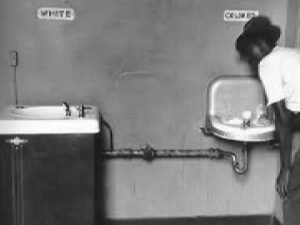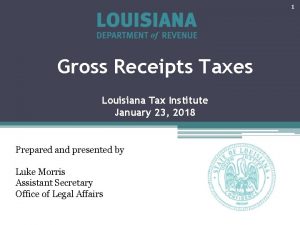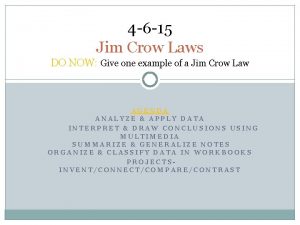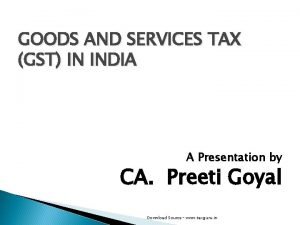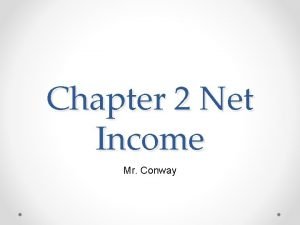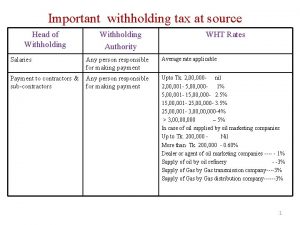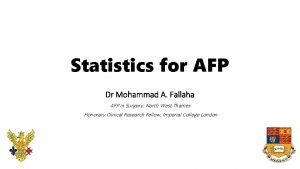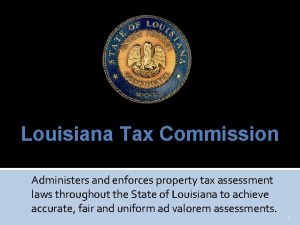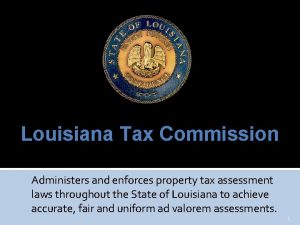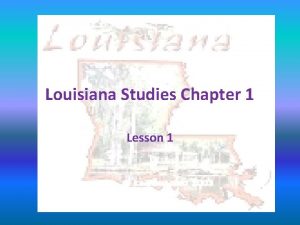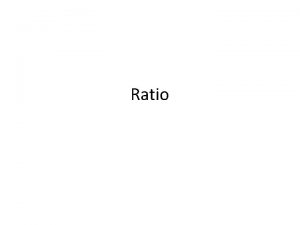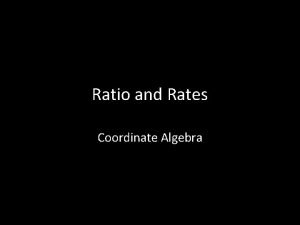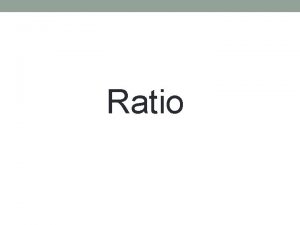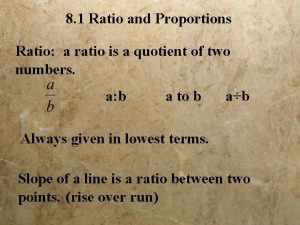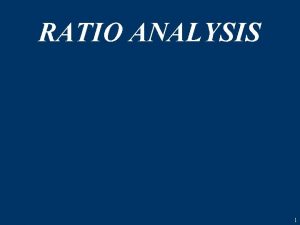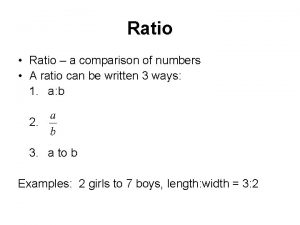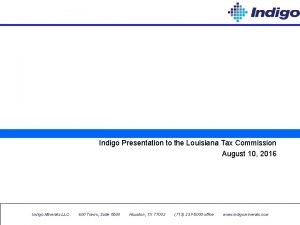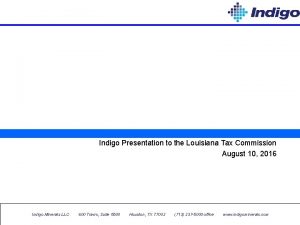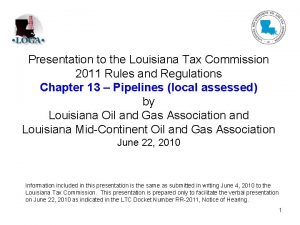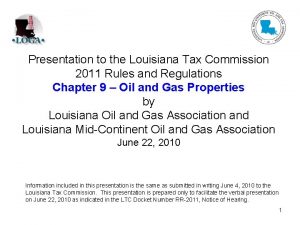LOUISIANA TAX COMMISSION RATIO STUDIES Why are ratio



















- Slides: 19

LOUISIANA TAX COMMISSION RATIO STUDIES

Why are ratio studies performed? R. S. 47: 1837 requires the Tax Commission to measure the accuracy and uniformity of tax assessments.

Ratio Studies (cont. ) This is done through ratio studies, which are performed annually on a statewide basis.

Types of Ratio Studies: Sales Land Residential Commercial Improvements

Ratio Study Procedures: Initially, for Sales, Land, and Residential studies: Collect all arms-length sales occurring six months before and after the reassessment date. This timeframe can be extended to one year on either side of the reassessment date, if necessary.

Ratio Study Procedures: (cont. ) Examples of sales not used: Sales involving courts, governmental entities, or public utilities Sales involving charitable, religious, or educational institutions Sales in which a financial institution is the buyer or seller

Ratio Study Procedures: (cont. ) Examples of sales not used (cont. ): Sales between relatives or corporate affiliates Estate Sales Land Sales over 3 acres in size

Sales Ratio Study Procedures Sales are arrayed by sale date. A random sampling is extracted from the sales. The sample should be reflective of sales throughout the year.

Land Ratio Study Procedures Vacant Land Sales are separated by subdivision or geographic area Specific property information, such as size, is obtained from various sources, assessor, clerk of court, etc. Sales are then analyzed to determine whether they can be correlated.

Land Ratio Study Procedures (cont. ) ▪ Three comparable sales are chosen for a subdivision/area and are used to determine the value of 10 -15 similar properties within that immediate area. Any necessary adjustments are made. ▪ The total number of subject properties depends upon the classification of the parish, small, medium, or large. ▪ All properties are inspected, photographed and plotted on maps.

Residential Ratio Study Residential sales are separated by subdivision or geographic area Size (living area) of the sales is obtained from the assessor’s office, MLS, or by measuring. Apex software is used to input measurements to determine size.

Residential Ratio Study (cont. ) Sales are analyzed to determine whether they can be correlated. The total sample size is determined by classification. Either small, medium, or large.

Residential Ratio Study (cont. ) Three comparable sales are chosen for a subdivision/area and are used to determine the value of 10 -15 similar properties within that area. Any necessary adjustments are made. All properties are inspected (exterior only), photographed, and plotted on maps. In very small parishes, if there is an insufficient number of sales, the Marshall & Swift Residential Cost Estimator is used to value the improvements.

Commercial Improvements Study A sample size is determined for each parish. Parishes are classified as either small, medium, or large. Subject properties are selected randomly throughout the entire parish and should include as many property types as possible.

Commercial Improvements Study (cont. ) The improvements are inspected, measured, and photographed. Apex software is used to determine the square footage of the improvements. Building specification data obtained through the field inspection is entered into the Marshall Swift Valuation software to derive replacement cost new less depreciation.

Measuring Compliance: After the rolls are closed, the assessed values are collected from the current tax roll The assessed value to appraised value ratio is then calculated. Appraised value to sale price ratio is used for the sales ratio study. The ratios are arrayed and outliers are extracted using Excel software.

Measuring Compliance (cont. ) The Median and Coefficient of Dispersion (COD) are calculated and used to determine compliance. For commercial improvements, the Median has to be between. 135 and. 165. For land residential properties the Median has to be between. 09 and 0. 11 In all studies, the COD has to be less than 20.

Measuring Compliance (cont. ) After the results are determined, but before they are considered final, the study is presented to the assessor for review. Typically, two weeks are given, but if requested, more time can be allowed. For parishes outside of compliance, the following year is given to reassess properties/areas where necessary. This reassessment is typically monitored on a bi-weekly or monthly schedule by LTC staff. At the end of the timeframe, LTC staff will perform another study to verify compliance.

In the Future Improving efficiencies Electronic submission Less disruption of Assessor office More Assessor Assistance Special Projects
 Insidan region jh
Insidan region jh Hey bye bye
Hey bye bye Louisiana 1918 poll tax receipt
Louisiana 1918 poll tax receipt Louisiana gross receipts tax
Louisiana gross receipts tax Louisiana 1918 poll tax receipt
Louisiana 1918 poll tax receipt Louisiana farm tax exemption
Louisiana farm tax exemption Louisiana housing commission
Louisiana housing commission Conclusion of gst
Conclusion of gst Roland purcell a technical writer
Roland purcell a technical writer Withholding tax for commission
Withholding tax for commission What is commission
What is commission What was the purpose of appointing mudaliar commission
What was the purpose of appointing mudaliar commission Marie earns an 8 commission
Marie earns an 8 commission Paradigm shift from women studies to gender studies
Paradigm shift from women studies to gender studies Don't ask why why why
Don't ask why why why Importance of social studies
Importance of social studies Why social study is important
Why social study is important Rr statistics
Rr statistics Reciprocal of velocity ratio
Reciprocal of velocity ratio Acid test ratio and quick ratio
Acid test ratio and quick ratio


